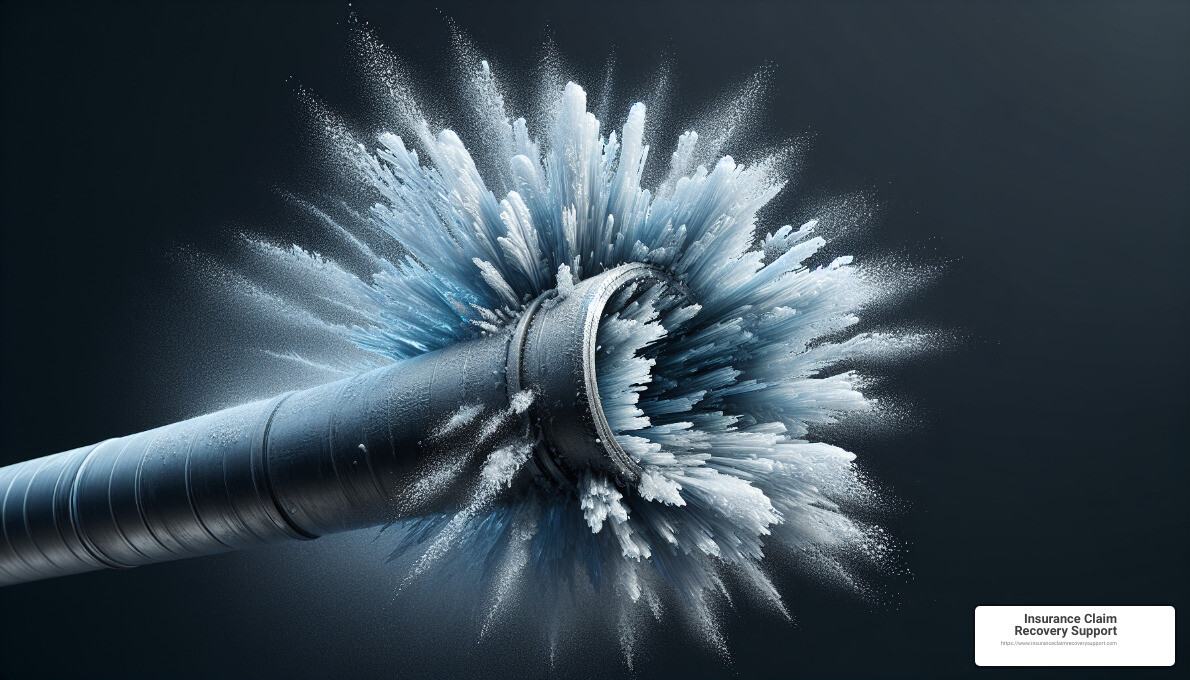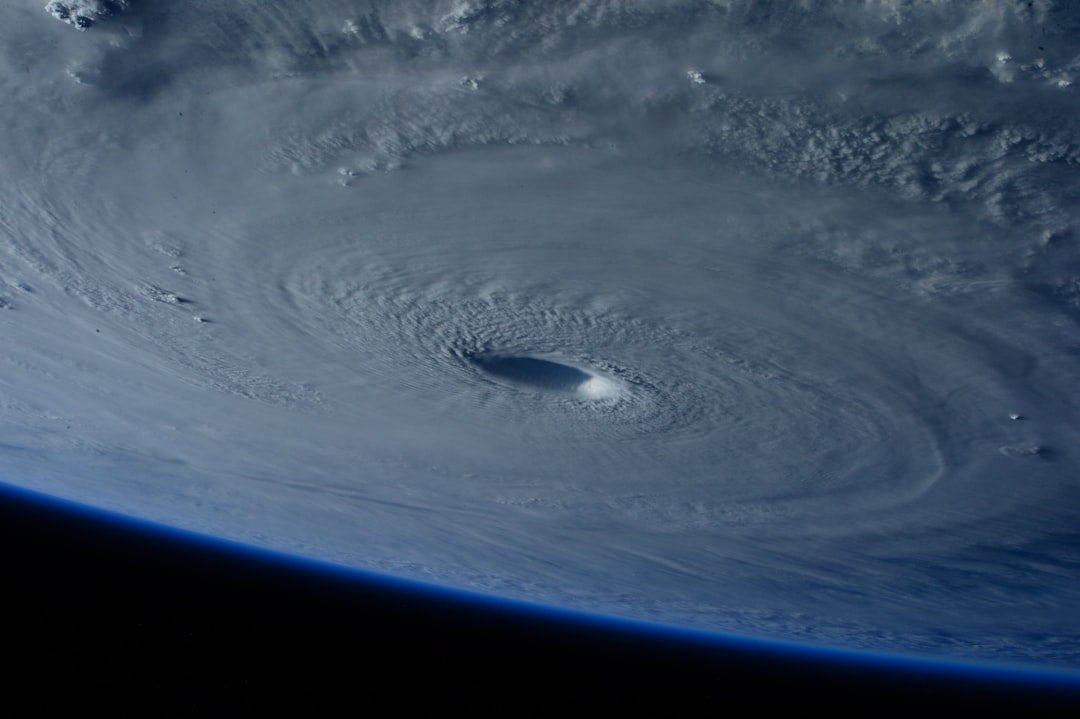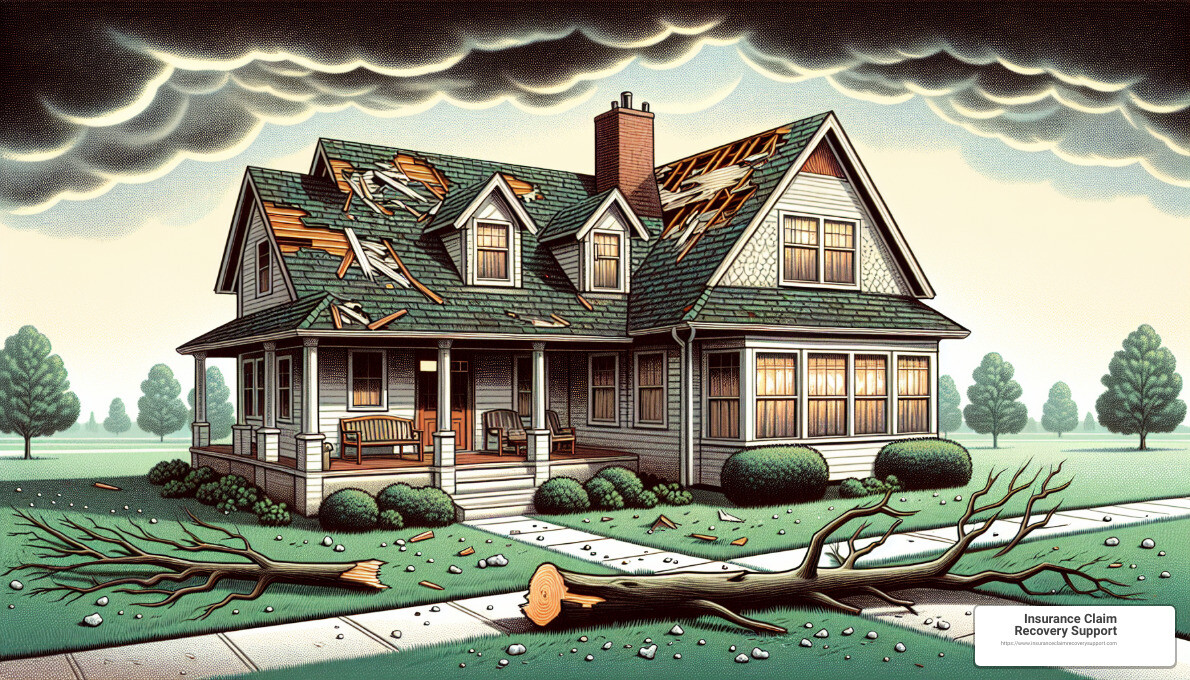When commercial and multifamily properties face the wrath of winter, freeze damage becomes a critical concern that demands immediate attention. This type of damage can significantly impact the structural integrity and safety of your buildings, leading to costly repairs and operational disruptions.
Quick Summary to Address Your Immediate Concerns:
– Identify Freeze Damage Early: Look for cracks, moisture, and signs of ice dams.
– Areas at Risk: Pipes, roofs, vacant units, and foundations are most susceptible.
– Immediate Actions: For frozen pipes, shut off water immediately to prevent bursts. For ice dams, ensure proper attic insulation and ventilation.
– Remediation is Key: Engage water mitigation companies quickly to avoid mold growth.
Frozen pipes that burst, ice dams that leak into walls, and unchecked moisture can quickly escalate into more severe issues like mold and structural damage. The importance of remediating water damage promptly cannot be overstated; it’s not just about repairs but preventing mold that can pose health risks and further damage to the property.
For commercial, multifamily, and apartment property owners, navigating the aftermath of freeze damage can be overwhelming. From dealing with the immediate water damage to filing insurance claims for a fair and prompt settlement, the process is fraught with complexities.

Understanding the types of freeze damage, common areas affected, and the process for remediation and insurance claims is crucial. This guide aims to arm you with the knowledge needed to tackle freeze damage head-on, ensuring the long-term viability of your property and peace of mind for your tenants and stakeholders.
Understanding Freeze Damage
Types and Causes
Freeze damage in buildings and structures often stems from the harsh reality of water’s unique property: it expands as it freezes. This expansion can exert tremendous pressure on whatever is containing it, including metal or plastic pipes. When the temperature drops significantly below freezing point, water inside pipes can freeze, leading to potential bursts and extensive water damage.
- Frozen Pipe Bursts: When water freezes in a pipe, it expands and can cause the pipe to burst, leading to significant water damage.
- Ice Dams: Ice dams occur when snow melts on a warm roof, then refreezes at the colder eaves, creating a dam that prevents melting snow from draining. Water can back up and leak into the building, causing damage to walls, ceilings, and insulation.
- Water Damage: Resulting from either burst pipes or ice dams, water damage can affect flooring, walls, and even the structural integrity of buildings.
- Mold: Moisture from water damage creates an ideal environment for mold growth, which can lead to health issues and further damage to the property.
- Sprinkler System Freeze Damage: Sprinkler systems are also vulnerable to freezing, which can lead to burst pipes and water damage throughout a commercial building or apartment complex.
Dealing with Water Mitigation Companies
Quick remediation is crucial to preventing mold and further damage. Water mitigation companies play a vital role in this process by swiftly removing water, drying out the affected areas, and restoring the property to its pre-damaged state. It’s essential to select a reputable company that can respond quickly and has experience dealing with freeze damage.
- Quick Response: Time is of the essence. The quicker the water is removed, and the area is dried, the lower the risk of mold growth and additional damage.
- Experience: Choose a company with experience in handling freeze damage specifically, as they will be more adept at identifying all affected areas and preventing further issues.
- Services: Ensure the company offers a comprehensive range of services, including water extraction, drying, mold remediation, and repair of damaged areas.
The importance of remediating water damage quickly to avoid mold cannot be overstated. Mold can begin to grow within 24 to 48 hours under the right conditions, presenting health risks and complicating the remediation process. By understanding the types of freeze damage and acting swiftly to address any issues, property owners can mitigate the impact and avoid long-term problems.
For more detailed information on freeze damage and its impact, visit Wikipedia’s page on Frost Damage.
The knowledge of freeze damage types, causes, and the critical steps to take immediately after discovering damage is essential for protecting your property and ensuring the safety and comfort of tenants. Proceeding to the next sections, we’ll delve into identifying freeze damage in buildings, the common areas affected, and how to handle the remediation and insurance claim process efficiently.
Identifying Freeze Damage in Buildings
Freeze damage in buildings, if not addressed promptly, can lead to significant structural issues and costly repairs. Identifying the early signs of damage is crucial for quick action. Here are key indicators to watch for:
Cracks
When water freezes and expands within the construction materials of a building, it can cause visible cracks. These cracks often appear in the foundation, exterior walls, and flooring. They are not just cosmetic issues but can signal deeper structural damage.
Moisture
Unexplained moisture or water pooling inside the building, particularly after a freeze-thaw cycle, can be a telltale sign of freeze damage. This moisture might come from burst pipes hidden within walls or ceilings, leading to water damage over time.
Ice Dams
Ice dams form when snow melts on a roof and then refreezes at the edge, preventing proper drainage. This can force water back under roof shingles or tiles, causing leaks and water damage to the interior of the building. Signs include icicles at the edge of the roof and water stains on ceilings.

Dealing with Ice Dams and Water Damage
Preventing ice dams involves ensuring your building has adequate insulation and ventilation in the attic. If ice dams have already formed, remove them carefully to prevent damage to the roof. Hiring professionals is recommended to safely remove the ice.
After identifying water damage, immediate remediation is crucial to prevent mold growth. Contacting water mitigation companies early can save you from extensive mold removal processes later.
The Importance of Quick Remediation
Mold can start to grow within 24-48 hours in moist conditions. Quick action is vital not only for the structure’s integrity but also for the health of the building’s occupants. Engaging a reputable water mitigation company ensures proper drying and restoration, mitigating the risk of mold.
Dealing with Water Mitigation Companies
When selecting a water mitigation company, look for one with a solid reputation and the necessary certifications. They should offer a comprehensive range of services, from water extraction and drying to mold remediation. Clear communication about the scope of work, timeline, and costs is essential to set the right expectations.
In conclusion, identifying freeze damage early, understanding its implications, and taking swift action are key to protecting your property. From the visible signs like cracks and moisture to more complex issues like ice dams, being proactive can mitigate the risks and costs associated with freeze damage. Engaging professionals for ice dam removal and water damage remediation is a critical step towards a swift recovery and prevention of future issues.
We’ll explore the common areas affected by freeze damage, how it impacts those areas, and the steps to take for effective handling and prevention.
Learn more about frost damage in construction)
Common Areas Affected by Freeze Damage
Freeze damage, especially in commercial buildings and apartment complexes, can lead to significant structural and property damage. Understanding the most vulnerable areas can help in early detection and prevention. Here are the key areas that are most commonly affected:
Pipes
- Location: Pipes located in external walls, unheated basements, and crawl spaces are at the highest risk.
- Impact: Water inside the pipes can freeze and expand, leading to bursts or cracks. This not only disrupts water supply but can also cause extensive water damage to the building.
- Prevention: Insulating pipes, keeping the heat on, and allowing faucets to drip slightly during extreme cold weather can prevent freezing.
Roofs and Gutters
- Location: Roofs, especially flat ones, and gutters are prone to collecting water and snow.
- Impact: Ice dams can form, preventing proper drainage and leading to water seeping under roofing materials, causing leaks and structural damage.
- Prevention: Proper insulation and ventilation of attics, along with regular cleaning of gutters, can help prevent ice dams.
Foundations
- Location: The foundation is the base of your building.
- Impact: When water in the soil around the foundation freezes and expands, it can exert pressure on the foundation causing cracks and structural damage.
- Prevention: Ensuring proper drainage away from the building and insulating foundation walls can mitigate this risk.
Dealing with Water Mitigation Companies
After freeze damage occurs, quick remediation is crucial to prevent further damage, such as mold growth. Water mitigation companies specialize in the clean-up and drying process after water damage occurs. Here’s why it’s important:
- Quick Response: These companies offer a rapid response to start the drying process as soon as possible, which is critical in preventing mold and further damage.
- Professional Assessment: They can provide a thorough assessment of the damage and a plan for remediation.
- Specialized Equipment: They use industrial-grade dehumidifiers, fans, and other equipment to effectively remove moisture from affected areas.
Selecting a reputable water mitigation company is important. Look for companies with certifications, good reviews, and a proven track record.
Handling Sprinkler System Freeze Damage
Sprinkler systems in commercial properties and apartment complexes are also susceptible to freezing.
- Inspection and Repair: It’s important to inspect these systems regularly and repair any damage immediately to prevent leaks and water damage.
- Prevention: Proper insulation and heating of spaces where sprinkler lines are located can prevent freezing.
Understanding these common areas affected by freeze damage and taking proactive measures for prevention and remediation can significantly reduce the risk and impact of freeze damage on commercial buildings and apartment complexes. Always prioritize safety and consult with professionals for inspection and repair to ensure a thorough and effective response to freeze damage.
Learn more about frost damage in construction)
The Impact of Frozen Pipes
When the temperature plummets, the water inside pipes can freeze. This is a common cause of freeze damage in commercial buildings and apartment complexes. Understanding the consequences of frozen pipes is crucial in mitigating damage and ensuring the safety and integrity of your property.
Bursts
Frozen water expands, putting immense pressure on pipes. This can lead to bursts, where pipes crack or split open. The aftermath? Significant water damage, potential flooding, and the disruption of water supply. Burst pipes are more than just an inconvenience; they’re a call to immediate action to prevent further damage.
Leaks
Not all pipe damage results in immediate bursts. Some pipes may develop small cracks that lead to leaks. While less dramatic, leaks can cause considerable damage over time, seeping into walls, ceilings, and floors, weakening structural components, and promoting mold growth.
Water Damage
The immediate consequence of burst or leaking pipes is water damage. Water can quickly spread, damaging floors, walls, equipment, and furnishings. In commercial settings, this can disrupt operations, leading to financial losses and potential health hazards if not addressed promptly.
Quick Remediation: Mold Prevention
Rapid response is critical. Water mitigation companies specialize in addressing water damage efficiently to prevent further issues, such as mold. Mold can start developing within 48 hours of water exposure, posing health risks and complicating cleanup efforts. Engaging professionals for water mitigation ensures thorough drying and sanitation, safeguarding your property against mold.
Working with Water Mitigation Companies
Selecting a reputable water mitigation company is vital. These companies play a crucial role in water extraction, drying, and repairing the damage. They also help in documenting the damage for insurance claims. Ensure the company you choose has experience with commercial properties and is licensed and insured.
Prompt action and professional assistance are key in managing the aftermath of frozen pipes. By understanding the impact and taking the necessary steps towards mitigation, you can protect your property and resume normal operations with minimal disruption.
In the face of freeze damage, being prepared and informed is your best defense.
Learn more about dealing with freeze damage
Dealing with Ice Dams and Water Damage
Freeze damage can wreak havoc on buildings, especially when it leads to ice dams and water damage. It’s crucial to understand how to handle these issues to protect your property.
Prevention
Insulate Your Attic: Proper insulation keeps the heat in your building, preventing the uneven temperatures that contribute to ice dam formation.
Ventilate the Roof: Ventilation helps maintain an even temperature on the roof, reducing the chances of ice dams forming.
Seal Leaks: Seal around electrical cables and vent pipes where warm air can escape, as these are potential spots for ice dams to start.
Removal
Ice Melt Products: Calcium chloride ice melt can be used to melt the ice. Avoid rock salt as it can damage your roof and plants.
Professional Removal: Consider hiring professionals to remove ice dams safely. They have the right tools and experience to do the job without damaging your roof.
Mitigation
Immediate Action: If water has penetrated your building, it’s vital to act quickly. Water damage can lead to mold, which poses health risks and damages the structure.
Water Mitigation Companies: Engaging a professional water mitigation company is crucial. They can efficiently dry out the affected areas, reducing the risk of further damage and mold growth. It’s essential to select a company with a track record of defending their work to insurers, ensuring you’re not left out of pocket if disputes arise over the mitigation invoice.
Documentation: Document all damage with photos and notes. This will be invaluable when filing an insurance claim.
The Importance of Quick Remediation
Quick action is not just about fixing immediate problems. It’s about preventing long-term issues like mold, which thrives in moist environments. A professional water mitigation company can help ensure that your property is dried correctly and thoroughly, mitigating the risk of mold. Mold can start to grow within 24 to 48 hours after water exposure. Therefore, the speed of your response is critical.
Dealing with Water Mitigation Companies
When selecting a water mitigation company, look for those with certifications and who follow industry standards, such as the IICRC S500 and S520 guidelines. A reputable company will not hesitate to defend their work to your insurer or adjust their invoice if necessary. Always discuss the scope of work and agree on payment terms in advance, ensuring they align with your insurance policy’s stipulations.
In summary, dealing with ice dams and water damage requires a proactive approach to prevent, remove, and mitigate damage. Engaging professional services when necessary can save you time and money in the long run, and quick remediation is crucial to prevent mold. Working closely with a trusted water mitigation company can ensure your property is restored properly and your insurance claim process goes smoothly.
In the aftermath of freeze damage, being prepared and informed is your best defense.
The Importance of Quick Remediation
Mold Prevention
When dealing with freeze damage, time is of the essence. The longer water is allowed to sit, the higher the risk of mold growth. Mold can start to grow within 24 to 48 hours under the right conditions, making quick action crucial. Mold not only poses health risks but can also lead to significant property damage and increase the cost of repairs.
Preventing mold starts with quick water removal and drying of the affected areas. Ensure that all wet materials are thoroughly dried or, if necessary, replaced. Keep humidity levels low and maintain good air circulation throughout the space to aid in drying and prevent mold spores from settling and growing.
Water Mitigation Companies
After identifying freeze damage, especially from burst pipes or ice dams, contracting a reputable water mitigation company should be your next step. These companies specialize in rapid water extraction and drying, which is vital for minimizing further damage and preventing mold.
A professional water mitigation company uses advanced equipment and techniques to remove water efficiently. They also help in drying out the premises, cleaning up, and sanitizing the area to prevent mold and other contaminants. Their expertise ensures that the water damage is handled correctly, reducing the risk of future issues.
Dealing with Water Mitigation Companies
Selecting the right water mitigation company is crucial. Look for companies with certifications and a solid track record of dealing with freeze damage. It’s important that they follow industry standards, such as the IICRC S500 and S520 guidelines for water damage restoration and mold remediation.
When working with water mitigation companies, clear communication is key. Ensure they provide a detailed plan of action and keep you informed throughout the process. Documentation of the damage and the remediation efforts is also vital for insurance purposes.
Quick Remediation and Insurance
Quick action not only prevents mold and minimizes damage but also impacts your insurance claim. Insurance companies typically require policyholders to take reasonable steps to mitigate further damage. By acting swiftly and documenting your efforts, you can support your insurance claim and potentially speed up the settlement process.
In summary, the aftermath of freeze damage demands immediate attention to prevent mold and further issues. Working with reputable water mitigation companies ensures that your property is restored efficiently and effectively. The faster you act, the better you can control the damage and the costs associated with repairs.
In the aftermath of freeze damage, being prepared and informed is your best defense.
Handling Sprinkler System Freeze Damage
After addressing immediate concerns like frozen pipes and ice dams, don’t overlook your sprinkler system. Sprinkler system freeze damage can be a silent headache that, if not addressed, leads to significant water waste and potential property damage when the system is reactivated in spring.
Inspection
As temperatures rise and it’s safe to assess your property, inspect your sprinkler system for any signs of freeze damage. Look for cracked pipes, broken sprinkler heads, and leaks. Sometimes, damage isn’t visible until the system is turned on, so be vigilant and watch for unusual water patterns or weak flow in certain areas.
Repair
If you identify any damage, it’s crucial to repair it promptly. Depending on the extent of the damage, you may need to replace sections of piping, sprinkler heads, or valves. For complex systems, especially in commercial buildings or apartment complexes, consider hiring a professional with experience in sprinkler systems. They can ensure repairs are completed correctly and efficiently, minimizing the risk of future issues.
Prevention
To avoid future freeze damage to your sprinkler system, take preventive measures before the cold season hits:
Drain the System: Remove all water from the pipes, valves, and sprinkler heads before the first freeze. You can use manual or automatic drain valves for this purpose.
Insulate: Protect any above-ground system components with insulation materials. This includes backflow preventers and valves that might be exposed to freezing temperatures.
Professional Winterization: Consider hiring a professional to winterize your system. They can ensure the system is fully drained and ready to withstand the winter, reducing the risk of freeze damage.
By following these steps, you can protect your sprinkler system from the harsh effects of freeze damage, ensuring it operates efficiently when you need it most. Prevention is always better than cure, and taking these measures can save you time, money, and hassle in the long run.
As we’ve seen, dealing with freeze damage requires a proactive approach. From identifying damage to engaging with water mitigation companies, every step taken is towards safeguarding your property and ensuring a swift recovery. Next, we’ll delve into the insurance claim process for freeze damage, providing key insights on how to navigate this crucial phase efficiently.
Insurance Claim Process for Freeze Damage
Navigating the insurance claim process for freeze damage can initially seem daunting. However, with the right approach and understanding, you can efficiently manage the situation. This section outlines the critical steps of documentation, filing, and settlement to ensure you’re well-prepared.
Documentation
The first step in addressing freeze damage is meticulous documentation. This means taking clear, detailed photos and videos of all affected areas. Whether it’s burst pipes, ice dams, or water damage, visual evidence is crucial. Also, maintain a record of all communications with your insurance company, including emails and call logs. This documentation will be invaluable when filing your claim.
Key Points:
– Photograph and video all damage.
– Keep a detailed record of damages and repairs.
– Document all interactions with your insurance company.
Filing
Once you have all necessary documentation, it’s time to file your claim. Contact your insurance provider to understand the specific steps required for filing. Be prepared to provide all collected evidence of the freeze damage. It’s important to file as soon as possible to avoid delays in processing and repair work.
Tips:
– Contact your insurance provider promptly.
– Provide comprehensive evidence of the damage.
– Follow your insurer’s specific filing requirements.
Settlement
The final phase is the settlement. Your insurance company will assess the damage, which may involve sending an adjuster to your property. It’s crucial to be present during this assessment to discuss the extent of the damage and your documentation. If the settlement offer from your insurance company doesn’t fully cover the damages, don’t hesitate to negotiate. You have the right to fair compensation for your losses.
Strategies:
– Be present during the insurance assessment.
– Negotiate if the settlement offer is insufficient.
– Consider seeking legal advice if necessary.
Working with Water Mitigation Companies
After filing the claim, start the remediation process quickly to prevent further damage, such as mold growth. Hiring a reputable water mitigation company can expedite this process. These companies specialize in quickly drying out water-damaged areas, preventing mold, and restoring your property. Ensure the company you select is experienced with insurance claims, as they can also assist in documenting the damage for insurance purposes.
Considerations:
– Act quickly to hire a water mitigation company.
– Ensure the company is experienced with freeze damage and insurance claims.
– Their documentation can support your insurance claim.
The insurance claim process for freeze damage is a critical step towards recovery. By focusing on thorough documentation, understanding the filing requirements, and being proactive during the settlement phase, you can navigate this process more smoothly. Additionally, working with professional water mitigation companies not only aids in quick remediation but also bolsters your claim with their expert documentation. The goal is to restore your property efficiently while ensuring you receive the compensation you deserve.
For further information on freeze damage and how to manage the insurance claim process, visit Frost Damage.
As we move towards preventing future freeze damage, consider the lessons learned during the insurance claim process and apply them to enhance your property’s resilience against similar incidents.
Working with Water Mitigation Companies
When dealing with freeze damage, working with a professional water mitigation company is crucial. These companies specialize in removing water and reducing further damage after events like pipe bursts or ice dams. Here’s how to navigate this process effectively:
Selection
Choosing the right water mitigation company is the first step. Look for companies with:
- Certifications: Ensure they follow industry standards, such as those set by the Institute of Inspection Cleaning and Restoration Certification (IICRC).
- Experience with freeze damage: Companies familiar with freeze damage understand the urgency and complexities involved.
- Good reputation: Check reviews and ask for references.
Services
Water mitigation companies offer various services that are critical after freeze damage, including:
- Water extraction: Removing standing water quickly to prevent further damage and mold growth.
- Drying and dehumidification: Using industrial fans and dehumidifiers to dry out wet areas.
- Mold prevention: Treating areas to prevent mold growth, which is a common problem after water damage.
- Content restoration: Salvaging and restoring personal property when possible.
Expectations
When you hire a water mitigation company, you should expect:
- Quick response: Time is of the essence. The company should be able to start work quickly to mitigate damage.
- Transparency: Clear communication about the scope of work, costs, and timeline.
- Professionalism: Respect for your property and understanding of the stress you’re under.
- Documentation: Detailed records of the damage and remediation efforts, which are crucial for insurance claims.
Importance of Quick Remediation
Acting fast is key to preventing further damage, including mold, which can start to grow within 24 to 48 hours. Mold not only poses health risks but can also complicate insurance claims and lead to higher costs.
Dealing with Water Mitigation Companies
To ensure a smooth process:
- Get approval from your insurer: Before engaging a water mitigation company, check with your insurance company. Some insurers have preferred providers or specific guidelines.
- Understand the contract: Know what you’re agreeing to, including any guarantees or warranties offered by the water mitigation company.
- Document everything: Keep records of all communications and work done, as this will be vital for your insurance claim.
Working with a reputable water mitigation company can significantly reduce the stress and impact of freeze damage. By choosing the right provider, understanding the services they offer, and setting clear expectations, you can navigate the aftermath of freeze damage more effectively.
Quick remediation is essential not only for the integrity of your property but also for the health and safety of its occupants. The goal is to restore your property to its pre-damage condition as efficiently as possible while minimizing the risk of future issues like mold growth.
For further information on handling freeze damage and maximizing your insurance claim, consider reaching out to professionals like Insurance Claim Recovery Support, who can advocate on your behalf and help ensure you receive the compensation you deserve .
As we look towards preventing future freeze damage, employing the lessons learned from working with water mitigation companies and managing insurance claims will be invaluable in strengthening your property’s defenses against similar incidents in the future.
Preventing Future Freeze Damage
Insulation: Proper insulation is your first line of defense against freeze damage. Ensure that all vulnerable areas such as pipes, attics, basements, and walls are well insulated. This helps maintain a consistent temperature within these spaces, reducing the risk of freezing.
Heating: Keep your property heated to at least 55 degrees Fahrenheit, even when unoccupied. For areas prone to freezing, consider installing heat tracing cables to keep pipes warm. Thermostatically controlled heat tapes can automatically adjust to the surrounding temperatures, providing warmth where it is most needed.
Maintenance: Regular maintenance plays a crucial role in preventing freeze damage. Before the cold season sets in, inspect your property for any cracks or gaps where cold air might penetrate and cause freezing. Seal these areas to keep the warmth in and the cold out. Additionally, ensure that your heating systems are in good working order and that vents are not blocked.
Drain Sprinkler Systems: For properties with sprinkler systems, draining them before the onset of freezing temperatures can prevent water from freezing and causing the pipes to burst. This preventative measure is simple yet highly effective in mitigating potential damage.
Roof and Gutter Maintenance: Ice dams can form when snow on the roof melts and refreezes at the edge, preventing proper drainage. Regularly cleaning gutters and ensuring adequate attic insulation can help prevent the formation of ice dams.
Detaching Hoses: Before the cold season, detach any hoses connected to outdoor faucets. Leaving them attached can lead to water accumulation and subsequent freezing, potentially causing pipes to burst.
Know Your Property: Familiarize yourself with the main water shut-off valve’s location. In the event of a pipe burst, quickly shutting off the water supply can minimize water damage.
Professional Inspections: Consider hiring professionals to conduct annual inspections of your heating and plumbing systems. Early detection of potential issues can save you from costly repairs due to freeze damage.
By implementing these preventive measures, you can significantly reduce the risk of freeze damage to your property. Regular maintenance, proper insulation, and proactive steps before the cold season can safeguard your property from the harsh effects of freezing temperatures. Prevention is always better than cure, and taking these actions can help protect your investment and provide peace of mind through the winter months.
Insurance Claim Recovery Support
After a freeze event, dealing with the aftermath can be overwhelming. This is where Insurance Claim Recovery Support (ICRS) steps in, offering a beacon of hope and assistance in navigating the complex process of insurance claims for freeze damage.
Advocacy
At the core of ICRS’s mission is advocacy for policyholders. The world of insurance claims can often feel like an uphill battle, with intricate policies and procedures that can confuse even the most seasoned property owners. ICRS stands as your champion, ensuring your voice is heard and your interests are represented. Our team of experienced public adjusters steps in to level the playing field between you and your insurance company.
Maximizing Settlements
Our goal is not just to help you file your claim but to maximize your settlement. Freeze damage, such as those from frozen pipe bursts, ice dams, and resultant water damage, can have devastating effects on commercial buildings and apartment complexes. The costs for repairs and remediation can quickly escalate, making it crucial to secure a settlement that covers all aspects of your loss.
We meticulously document the damage, employing our expertise to build a compelling case for the full extent of your losses. Our negotiations are grounded in facts and evidence, aimed at ensuring you receive the maximum insurance claim settlement you deserve in the minimum time possible.
Working with Water Mitigation Companies
An integral part of recovering from freeze damage is dealing with water mitigation companies. Rapid response is crucial to prevent further damage, such as mold growth, which can add to the complexity and cost of your claim. ICRS can guide you in selecting reputable water mitigation companies, ensuring that the remediation process is thorough and effective. We understand the importance of quick and efficient water damage remediation to prevent mold and other long-term issues.
By partnering with ICRS, you not only gain an advocate and expert in maximizing your settlement but also a guide to navigate the intricate process of recovery and remediation following freeze damage. Our commitment to our clients is unwavering, and our track record speaks for itself. If you’re facing the daunting task of recovering from freeze damage, let ICRS be your ally in ensuring your property and peace of mind are restored as swiftly as possible.
For more detailed information on how we can assist you, visit InsuranceClaimRecoverySupport.com.
Conclusion
In the wake of a freeze event, the path to recovery can seem overwhelming. From identifying the initial signs of freeze damage to navigating the complexities of insurance claims, the journey requires diligence, knowledge, and timely action. Freeze damage, whether from frozen pipe bursts, ice dams, or sprinkler system failures, doesn’t just impact the structural integrity of your buildings; it can also lead to significant water damage and subsequent mold growth if not addressed promptly.
Quick remediation is crucial. Engaging with reputable water mitigation companies early on can prevent mold and further damage, ensuring your property is dried and restored efficiently. It’s not just about fixing what’s broken; it’s about safeguarding your property’s future integrity and value.
When facing such challenges, having a professional advocate by your side can make all the difference. Insurance Claim Recovery Support (ICRS) specializes in guiding commercial property owners through the insurance claim process, ensuring you receive the full benefit of your policy. Our expertise in dealing with freeze damage claims, combined with our commitment to our clients, ensures that your recovery process is as smooth and successful as possible.
As you move forward, consider steps to prevent future freeze damage. Insulation, proper heating, and regular maintenance can drastically reduce the risk of freeze-related issues. It’s about being proactive, rather than reactive, to the whims of the weather.
Let us help you navigate this journey. At ICRS, we’re not just your advocate; we’re your partner in recovery. We understand the challenges you’re facing, and we’re here to help you overcome them. From dealing with water mitigation companies to maximizing your insurance settlement, we’ve got your back.
For more detailed information on how we can assist you with freeze damage and other storm-related claims, visit our Insurance Claim Recovery Support service page. Together, we can restore your property and your peace of mind.
Recovering from freeze damage is a journey, but with ICRS, you’re not on it alone. Let’s tackle this challenge together and turn a setback into a step forward.









